From the first days of January, which saw birders in the Hanover-Norwich and Mount Abraham Christmas Bird Count circles completing the last VT CBCs of the 2022-23 season, to the final days of December that welcomed a new state first species to Vermont (the above-pictured Ash-throated Flycatcher in a Middlebury cul-de-sac) 2023 was another year for the birding books. This year also marked the 13th annual Vermont eBird County Quest, a friendly competition encouraging birders statewide to submit their bird sightings to Vermont eBird.
The annual year-long contest pits county versus county, birder against birder, all engaged in a friendly rivalry for top birding honors. The main idea behind the year-long quest is simply to get people out birding, promote camaraderie, and better document bird life across the state using Vermont eBird.
2023 marked the 20th year for Vermont eBird, the first state or provincial portal to exist on the site. Bird watchers have shared an astounding number of checklists, making Vermont eBird (a project of the Vermont Atlas of Life) the largest community science biodiversity project in the state. In 2023 alone 4,293 eBirders in Vermont contributed a grand total of 100,625 checklists, cementing Vermont in 35th and 30th place respectively in the U.S. That’s not too shabby for a state with such a small population!
Since 2003, more than 15,000 Vermont eBirders have submitted more than 693,000 complete checklists, representing all 392 species of birds ever reported from Vermont. We’ve added over 190,000 images, over 18,000 sound recordings, and 320 videos to Vermont checklists, creating an incredible open-access resource for all.
It isn’t just about Vermont. More than 1.5 billion bird sightings have now been entered into eBird worldwide. This includes more than 247 million observations submitted this year. eBird records now make up more than half of all all biodiversity data in the Global Biodiversity Information Facility (GBIF).
Science and Conservation
And, of course, eBird isn’t just for fun. It’s a great tool for conservation, too. 2023 was another milestone year for eBird, delivering a new era of scientific applications, innovative new birding tools, and much more. As always, all of this is 100% free of charge to anyone who wishes to use it.
Your eBird observations throughout the year continued to contribute to the expansion of eBird Status and Trends with new modeled abundance and range maps for 356 species and 266 new population trend maps. In addition to these new maps to explore, eBird helped strengthen the connections between community scientists and bird conservation agencies by introducing new custom mapping tools and regional-level trend summaries. Now conservation organizations like The Nature Conservancy, local land trusts, and the World Wildlife Fund can more readily use eBird data to inform conservation decision-making, and birders can also use these tools to learn where a certain species they’re searching for might be most common.
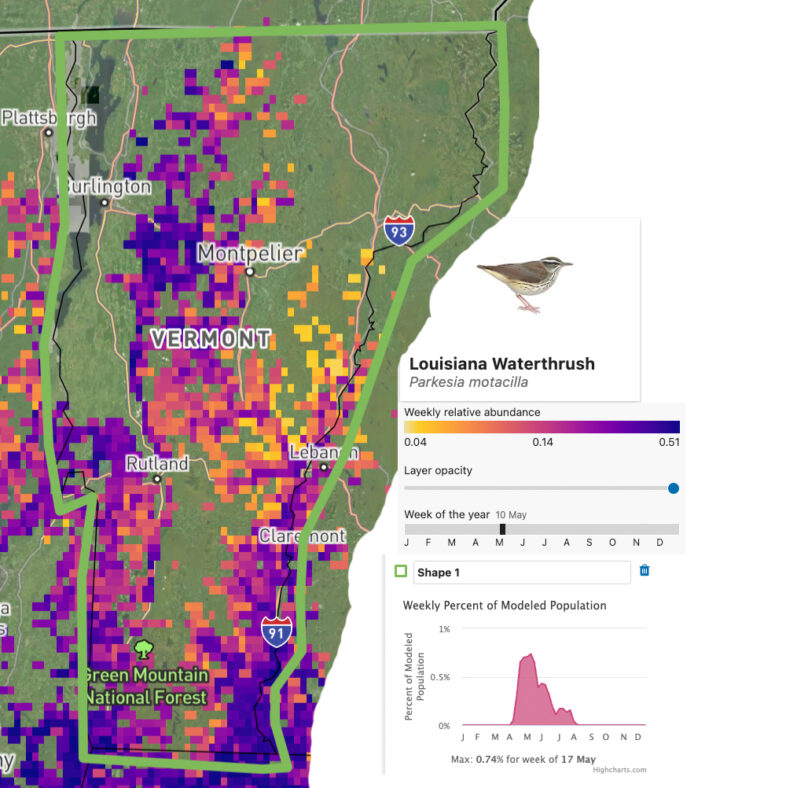
Estimate of relative abundance for Louisiana Waterthrush in Vermont for the week of 17 May. Weekly Percent of Modeled Population (right) indicates the percentage of the population likely to be present within the borders of the custom shape throughout the year. Visit the A Status and Trends tool to explore more – https://science.ebird.org/en/vt/status-and-trends/species/louwat/trends-map
One major eBird update that took place early in 2023 involved how the database handles exotic and introduced species. Now birders across Vermont can report species such as Northern Bobwhite, Ring-necked Pheasant, Graylag Goose, and others that have either been intentionally released or have unintentionally escaped in areas where they are not native. As botanists, entomologists, and many other experts know all too well, tracking invasive and/or exotic species is critical to understanding their potential effects on our native species. Now Vermont birders can log these uniquely important and unusual species in eBird to track their arrival and potential expansion in areas while avoiding adding non-native species to their eBird life lists.
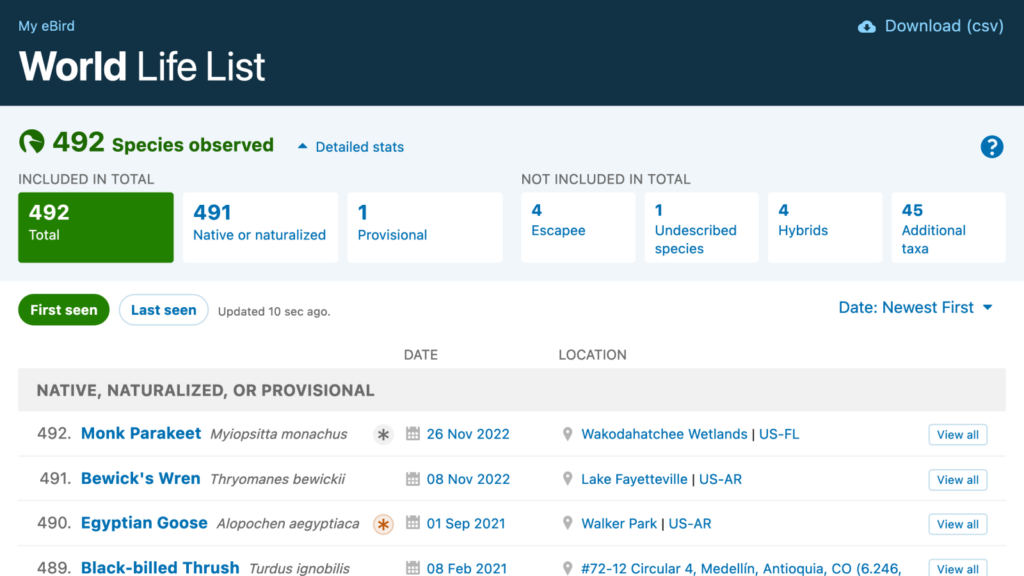
Now you can report every free-roaming, non-captive bird you see or hear without wondering how that species might affect your personal species totals.
Researchers published 150 peer-reviewed publications in 2023 incorporating eBird data bringing the total number of scientific publications using eBird data to more than 930. The vast database of bird photos, audio recordings, and video clips known as the Macaulay Library continued to expand, with more than 12 million photos and 454,000 recordings added to the library in 2023.
The 13th Annual Vermont eBird County Quest Champions
With 28 species over par, Windsor County emerged victorious after two consecutive winning years for neighboring Orange County. Congratulations to the many birders who helped Windsor County claim the 2023 Quest Cup. Much like its geographic location, Windham county finished just south of Windsor in the rankings with an impressive 21 species over par.
The County Cup award is based on a carefully calculated “par” system, recognizing that not all Vermont counties are created equal in terms of avian diversity. Par scores reflect the number of species that a given county should find in a year with consistent birding effort. Each year a particular county wins, five birds are added to their par.
After a surprise appearance by Addison County at the top of the species total rankings last year, Chittenden has reclaimed its usual top spot with a grand total of 245 species. Addison was only 2 species behind with 243, and we expect these two ecologically and ornithologically diverse counties to be neck and neck for years to come.
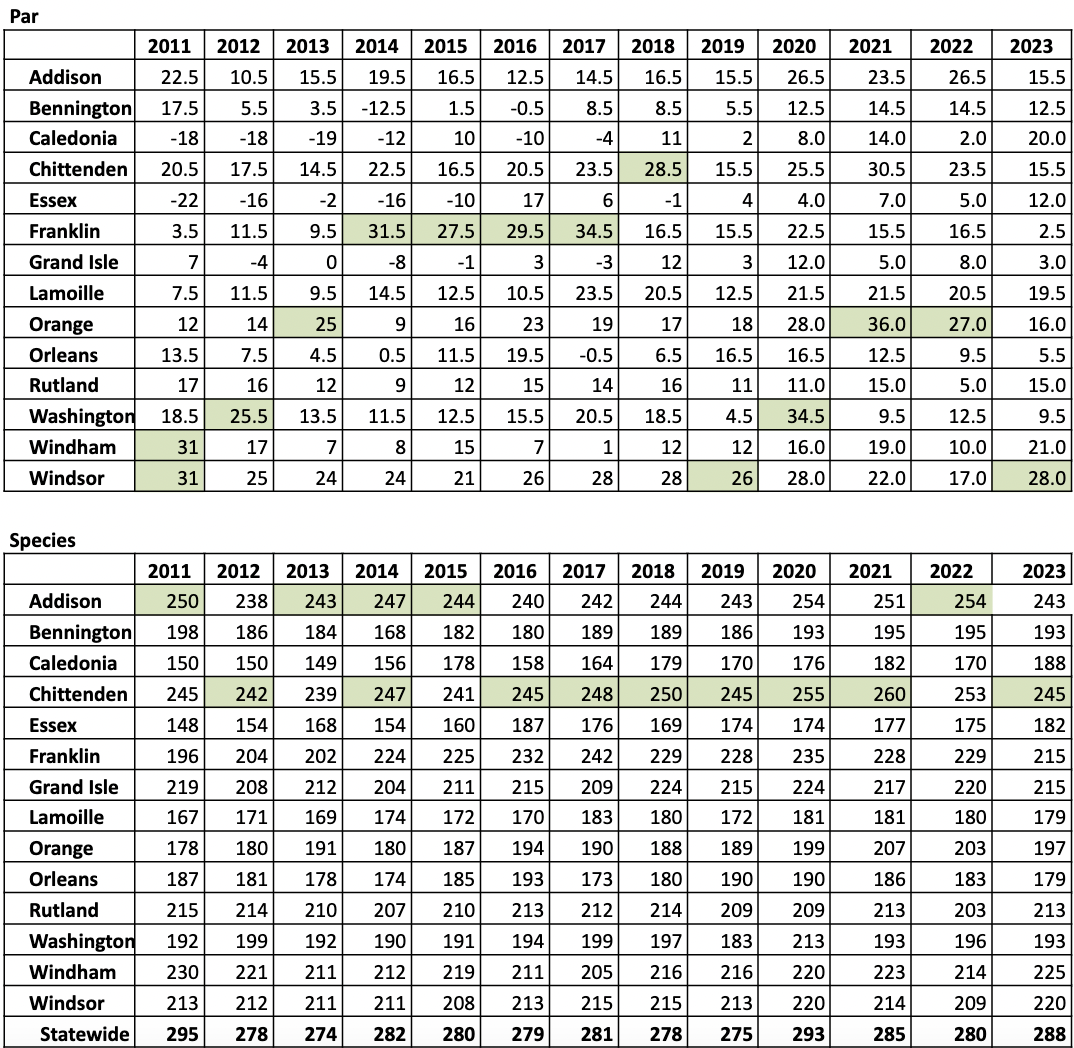
Individual County Winners
These titles are awarded to the birders with the most checklists for each county and to the birders with the highest species count for each county. No par or weighting necessary for this one!
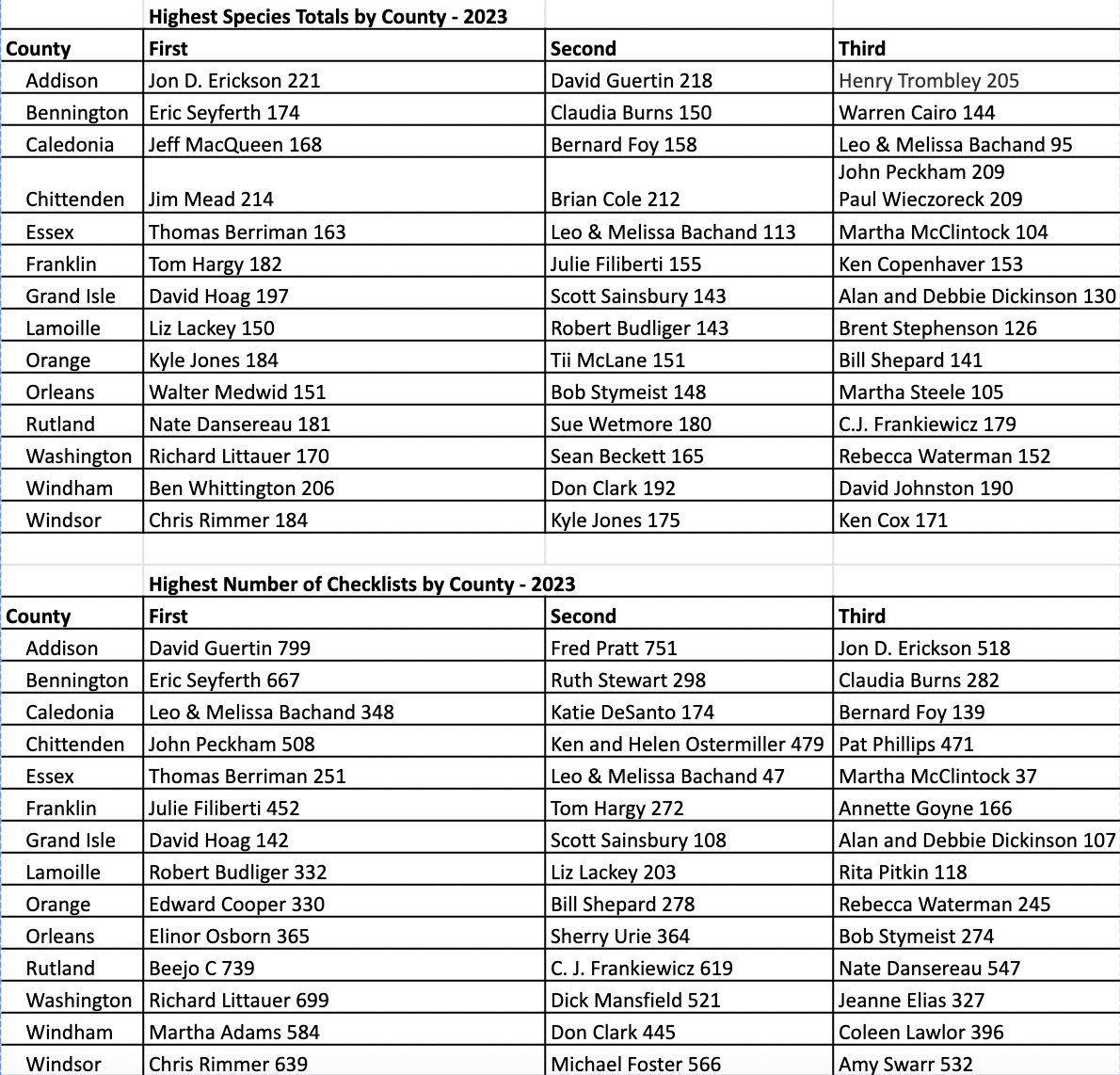
Visit the Vermont eBird Top 100 list to get a full tally of Checklist and Species List Champions for any year. Simply select the county and year you are interested and see where you ranked, too!
Statewide Winners
Many birders ventured outside their home county, of course. Jim Mead continued his dominance in total species observed with a final tally of 253 species, followed closely behind by John Peckham and Jon D. Erickson (who both tied for 2nd place last year) with 244 and 239 species respectively. After many years of dedicated data reviewing and thousands of eBird checklist submissions, Ian Worley stepped down from his position as reviewer and a new birder has reached the top of the checklist charts. Congratulations to C.J. Frankiewicz on his 974 checklists submitted in 2023. Continuing the shakeup at the top of the checklist rankings are two other new champions – Fred Pratt with 953 checklists and Nate Dansereau with 925 checklists.
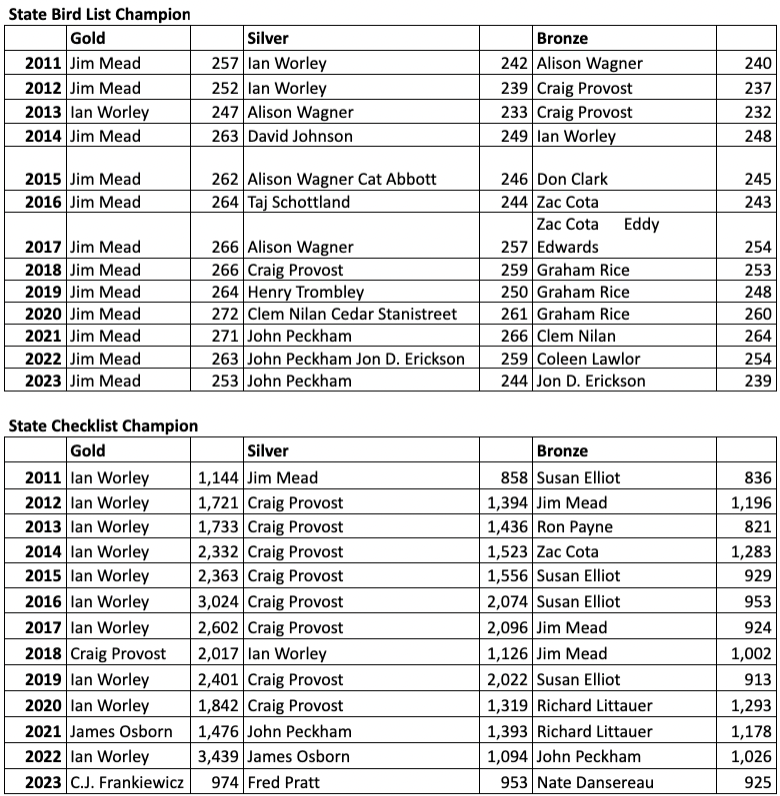
The County 150 Club
eBirders who identified 150 species or more in a county are inducted into the prestigious “150 Club.” Even in counties with higher avian diversity, a birder must be dedicated and in the field during all four seasons to join this club. Seventeen Vermont eBirders added their names to the roll in 2023. Check out the 150 Club honor roll to see how you and your birding friends have done.
The Vermont 250 Club
The Vermont 250 Club requires even more dedication. This is a list of eBirders who’ve found 250 or more bird species in Vermont during one calendar year and reported them to Vermont eBird. To complete this, birders have to find about 90% of the species found in Vermont in any given year. Jim Mead has passed 250 species 12 times as of this year!
Cat Abbott (2018)
Zac Cota (2017)
Jacob Crawford (2021)
Eddy Edwards (2017)
Jon D. Erickson (2021, 2022)
Coleen Lawlor (2022)
Bill Mayville (2017)
Mae Mayville (2017)
Jim Mead (2011, 2012, 2014, 2015, 2016, 2017, 2018, 2019, 2020, 2021, 2022, 2023)
Clem Nilan (2018, 2020, 2021)
John Peckham (2021, 2022)
Craig Provost (2018)
Graham Rice (2018, 2020)
Cedar Stanistreet (2020)
Allan Strong (2021)
Henry Trombley (2019, 2020, 2022)
Alison Wagner (2017)
You can see the entire ranked list for each year by visiting the Vermont eBird Top 100.
Congratulations to everyone for a fun year of birding! We hope some of you will vie for top honors in 2023. You can follow the scoreboard all year long and see where you rank. Even if you come up short, all of the data collected in Vermont eBird is valuable for science, education, and conservation. Best of luck eBirding!
Thank You to All our Volunteers, Collaborators and Sponsors!
We’d like to thank the volunteer data experts that help us keep Vermont eBird data strong – Cat Abbott, Tom Berriman, Zac Cota, Jacob Crawford, Sue Elliott, Kyle Jones, Richard Littauer, Coleen Lawlor, Jeff MacQueen, Kent McFarland, Chris Rimmer, Bob Stymeist, and Chad Witko. Several of these fantastic volunteer data reviewers are new to their respective posts, and we encourage you to get to know our new reviewers. Every record entered into Vermont eBird is checked for accuracy, first by automated filters that flag unusual records, and then by expert reviewers who devote their personal time to ensure that your lists and the eBird database are as accurate as possible. Additionally, Ron Payne, and Kent McFarland are hotspot editors for Vermont. If you run into them while out birding, let them know you are thankful for their hard work and contribution behind the scenes at Vermont eBird.
And finally, thank you to all of Vermont eBird collaborators and sponsors that help make Vermont eBird a special place.

